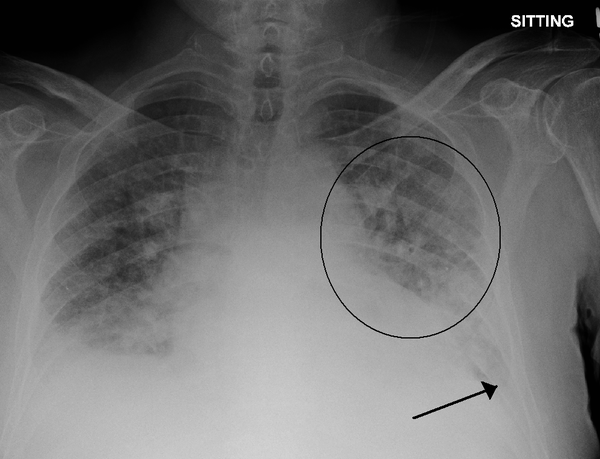Sandbox:farnaz: Difference between revisions
Jump to navigation
Jump to search
No edit summary |
Usama Talib (talk | contribs) |
||
| Line 12: | Line 12: | ||
=== Type 1: === | === Type 1: === | ||
{{familytree/start}} | |||
{{familytree | | | | | | | | | | | | | | | | | | | | | A01 | | | | | | | |A01=Pulmonary edema}} | |||
{{familytree | | | | | | | | | | | | |,|-|-|-|-|-|-|-|-|^|-|-|-|-|-|-|-|-|.| }} | |||
{{familytree | | | | | | | | | | | | C01 | | | | | | | | | | | | | | | |C02|C01=Cardiogenic|C02=Non-cardiogenic}} | |||
{{familytree | |,|-|-|-|v|-|-|-|v|-|-|^|-|-|v|-|-|-|v|-|-|-|.| | | | | | |!| }} | |||
{{familytree | D001 | | D002 | | D003 | | | |D004 | | D005 | | D006 | | | | | |!| | | | | |D001=LV failure|D002=Dysrthmia|D003=LV hypertrophy and cardiomyopathy| D004=Volume Overload|D005=MI|D006=LV outflow obstruction| |}} | |||
{{familytree | | | | | | | | | | | | | | | | |,|-|-|-|-|-|-|-|-|-|-|-|-|-|+|-|-|-|-|-|-|-|-|-|-|-|-|-|.|}} | |||
{{familytree | | | | | | | | | | | | | | | | E02 | | | | | | | | | | | | |E03 | | | | | | | | E04 |E01=E01|E02=E02|E03=E03|E04=E04}} | |||
{{familytree | | | | | |,|-|-|-|v|-|-|-|v|-|-|^|-|-|v|-|-|-|v|-|-|-|.| | | |!| | | | | | | |!| | }} | |||
{{familytree | | | | | F01 | | F02 | | F03 | | | | F04 | | F05 | | F06 | | |!| | | | | | | | | | | | | | | | | | | | | | | |F01=F01|F02=F02|F03=F03}} | |||
{{familytree/end}} | |||
|,|-|-|-|v|-|-|-|+|-|-|-|v|-|-|-|. | |||
=== Type 2: === | === Type 2: === | ||
Revision as of 21:04, 9 February 2018
Editor-In-Chief: C. Michael Gibson, M.S., M.D. [1]; Associate Editor(s)-in-Chief: Farnaz Khalighinejad, MD [2]
Overview
This is my sandbox.
Image reference

Source: Wikimedia commons
Type 1:
| Pulmonary edema | |||||||||||||||||||||||||||||||||||||||||||||||||||||||||||||||||||||||||||||||||||||||||||||||||||||||||||||
| Cardiogenic | Non-cardiogenic | ||||||||||||||||||||||||||||||||||||||||||||||||||||||||||||||||||||||||||||||||||||||||||||||||||||||||||||
| LV failure | Dysrthmia | LV hypertrophy and cardiomyopathy | Volume Overload | MI | LV outflow obstruction | ||||||||||||||||||||||||||||||||||||||||||||||||||||||||||||||||||||||||||||||||||||||||||||||||||||||||
| E02 | E03 | E04 | |||||||||||||||||||||||||||||||||||||||||||||||||||||||||||||||||||||||||||||||||||||||||||||||||||||||||||
| F01 | F02 | F03 | {{{ F04 }}} | {{{ F05 }}} | {{{ F06 }}} | ||||||||||||||||||||||||||||||||||||||||||||||||||||||||||||||||||||||||||||||||||||||||||||||||||||||||
|,|-|-|-|v|-|-|-|+|-|-|-|v|-|-|-|.
Type 2:
The primary therapy for MS may include:[1][2]
- B-interferon
- Teleflunomide
96 patients (174 eyes, 70% females) were included with a mean age at presentation of 30 years
| Cause | Symptom | Diagnosis | Treatment |
|---|---|---|---|
| 1 | |||
| 2 | |||
| 3 |
References
- ↑ Kamm CP, Uitdehaag BM, Polman CH (2014). "Multiple sclerosis: current knowledge and future outlook". Eur Neurol. 72 (3–4): 132–41. doi:10.1159/000360528. PMID 25095894.
- ↑ Schwartz K, Wymbs NF, Huang H, Mealy MA, Pardo CA, Zackowski K; et al. (2017). "Randomized, Placebo-controlled Crossover Study of Dalfampridine Extended-release in Transverse Myelitis". Mult Scler J Exp Transl Clin. 3 (4): 2055217317740145. doi:10.1177/2055217317740145. PMC 5731631. PMID 29270309.